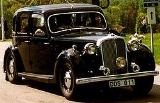
Rover P3
Encyclopedia
The Rover P3 car produced by the Rover
company in 1948 and 1949 was very much an interim model.
For the post-war market Rover had a new engine that had been in preparation since the late 1930s with overhead inlet and side exhaust valves. It was made in two version for the car, the "60" had a four-cylinder unit of 1595 cc and the "75" had a six-cylinder version of 2103 cc. The gearbox and traditional Rover freewheel
were kept unchanged from the previous model.
To go with the engine a new car was prepared. Although the body was similar in styling to the Rover 12 and 16, many of the body panels were in fact new but the wings and bonnet from the 12 were carried over. The car was 0.5 inch (12 mm) wider outside than the 16 but by making better use of space this translated to 2.5 inches (60 mm) inside. It was 4.5 inches (115 mm) shorter in the wheelbase. Also new, and a first for a Rover, was independent front suspension but the brakes remained a hydraulic/mechanical hybrid system. Rather than having a complete chassis, the new frame, which was a box section, was stopped short of the rear axle and the rear semi-elliptic springs were attached to the body. This allowed the rear axle travel to be increased and an improved ride resulted.
Two body styles were available, a six light saloon and four light "Sports Saloon".
The cars were expensive at £1080 for the "60" and £1106 for the "75", and with early post-war production problems and material shortages it was never intended that the cars would be produced in large numbers. Eventually, 1274 of the "60" and 7837 of the "75" models were made before the car was replaced by the all-new P4
of 1949.
The engine and gearbox from the car were also used as the basis for those in the original Land Rover Series
.
Rover (car)
The Rover Company is a former British car manufacturing company founded as Starley & Sutton Co. of Coventry in 1878. After developing the template for the modern bicycle with its Rover Safety Bicycle of 1885, the company moved into the automotive industry...
company in 1948 and 1949 was very much an interim model.
For the post-war market Rover had a new engine that had been in preparation since the late 1930s with overhead inlet and side exhaust valves. It was made in two version for the car, the "60" had a four-cylinder unit of 1595 cc and the "75" had a six-cylinder version of 2103 cc. The gearbox and traditional Rover freewheel
Freewheel
thumb|Freewheel mechanismIn mechanical or automotive engineering, a freewheel or overrunning clutch is a device in a transmission that disengages the driveshaft from the driven shaft when the driven shaft rotates faster than the driveshaft...
were kept unchanged from the previous model.
To go with the engine a new car was prepared. Although the body was similar in styling to the Rover 12 and 16, many of the body panels were in fact new but the wings and bonnet from the 12 were carried over. The car was 0.5 inch (12 mm) wider outside than the 16 but by making better use of space this translated to 2.5 inches (60 mm) inside. It was 4.5 inches (115 mm) shorter in the wheelbase. Also new, and a first for a Rover, was independent front suspension but the brakes remained a hydraulic/mechanical hybrid system. Rather than having a complete chassis, the new frame, which was a box section, was stopped short of the rear axle and the rear semi-elliptic springs were attached to the body. This allowed the rear axle travel to be increased and an improved ride resulted.
Two body styles were available, a six light saloon and four light "Sports Saloon".
The cars were expensive at £1080 for the "60" and £1106 for the "75", and with early post-war production problems and material shortages it was never intended that the cars would be produced in large numbers. Eventually, 1274 of the "60" and 7837 of the "75" models were made before the car was replaced by the all-new P4
Rover P4
The Rover P4 series was a group of saloon automobiles produced from 1949 through to 1964 designed by Gordon Bashford. The P4 designation is factory terminology for the group of cars and was not in day-to-day use by ordinary owners, who would have said simply that they had a "Rover 90" and so on.The...
of 1949.
The engine and gearbox from the car were also used as the basis for those in the original Land Rover Series
Land Rover Series
The Land Rover Series I, II, and III are off-road vehicles produced by the British manufacturer Land Rover that were inspired by the US-built Willys Jeep...
.

